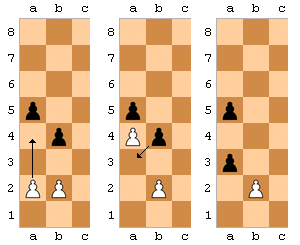
In chess, en passant (French: [ɑ̃ pasɑ̃], lit. "in passing") describes the capture by a pawn of an enemy pawn on the same rank and an adjacent file that has just made an initial two-square advance.[2][3] This is a special case in the rules of chess. The capturing pawn moves to the square that the enemy pawn passed over, as if the enemy pawn had advanced only one square. The rule ensures that a pawn cannot use its two-square move to safely skip past an enemy pawn.
Capturing en passant is permitted only on the turn immediately after the two-square advance; it cannot be done on a later turn.[4] The capturing move is sometimes notated by appending the abbreviation e.p.
- ^ a b "FIDE Laws of Chess taking effect from 1 January 2018". FIDE. Archived from the original on 23 January 2021. Retrieved 6 June 2022.
- ^ Article 3.7.4.1 in the FIDE Laws of Chess[1]
- ^ Brace, Edward (1977), "en passant", An Illustrated Dictionary of Chess, Secaucus, N.J: Craftwell, ISBN 1-55521-394-4
- ^ Article 3.7.4.2 in FIDE Laws of Chess[1]